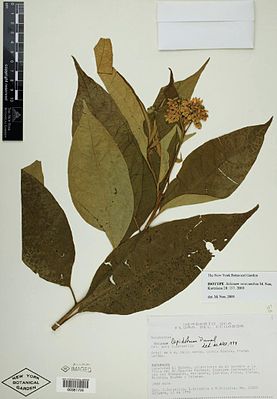Solanum verecundum
| Solanum verecundum | ||||||||||||
|---|---|---|---|---|---|---|---|---|---|---|---|---|

Isotype of Solanum verecundum |
||||||||||||
| Systematics | ||||||||||||
|
||||||||||||
| Scientific name | ||||||||||||
| Solanum verecundum | ||||||||||||
| M.Nee |
Solanum verecundum is a species ofthe nightshade family (Solanaceae). It was first described in 2000 and is native to Ecuador and Peru .
description
Solanum verecundum grows as a shrub or small tree that can reach heights of 4 to 14 meters. The trunk is densely covered with trichomes . The star- to shield-shaped trichomes are 0.2 to 0.3 millimeters long, stand in ten to twelve rows and have grown together up to half their total length. The young shoots are densely covered with star-shaped trichomes, which are similar to the trunk and turn pale golden brown when they dry out. The bark of older trunks is colored red-gold due to the trichomes.
The sympodial units include some leaves . The simple leaves are between 6 and 19 inches long and between 2 and 10 inches wide. The skin-like or paper-like leaf blade is approximately elliptical to elliptical in shape. Its base is pointed like the tip and its smooth leaf margins are entire. The upper side of the leaf is evenly covered with some star-shaped up to 15-row trichomes, which are only grown together in their lower part. The underside of the leaf is densely covered with star-shaped, up to 16-row trichomes, which can be up to 0.4 millimeters thick. From the leaf axis 12 to 15 pairs of primary leaf veins branch off, which are densely hairy on the underside of the leaf. The 1 to 4 centimeter long petiole is densely covered with star- to shield-shaped trichomes.
The inflorescences are terminal on the stems. They are 7 to 10 centimeters long and are branched in many ways. Each of the inflorescences consists of more than a hundred flowers. The inflorescence is densely hairy with star- to shield-shaped trichomes, which resemble those of the trunk. The flower stalk , nodding at flowering time , is 2 to 5 centimeters long and 1 to 1.5 millimeters thick at the base and about 1.5 millimeters thick at the top. It is densely covered with trichomes and is bent like a joint at the base. The flower stalks are 5 to 6 millimeters long and about 1 millimeter apart.
The five-fold flowers are always fully developed. The cup-shaped calyx tube is between 1 and 1.5 millimeters long and covered with 1 to 1.5 millimeters long, triangular lobes. The dense hair on the underside of the calyx resembles that of the rest of the inflorescence, while the top of the calyx is only sparsely hairy. The white crown measures 1 to 1.2 centimeters in diameter, lobes in a star shape up to three quarters of the way to the base. The corolla lobes, which are bent back to the flower, are 4 to 5 millimeters long, 2 to 2.5 millimeters wide and their edges and tips are densely hairy. The top of the corolla lobes is hairless, while the underside is densely covered with star-shaped, roughly ten-row trichomes. The hairless stamens are fused into a tube, and the free-standing part is about 1 millimeter long. The yellow anthers are elliptical in shape with a length of 2.5 to 3 millimeters and a width of about 1 millimeter. They open through pores at the tips, which enlarge into slits with age. The ovary is densely hairy with branched to star-shaped trichomes. The stylus is 6 to 6.5 millimeters long and densely covered with star-shaped, four- to six-row trichomes, which are about 0.2 millimeters long. The head-shaped scar is finely papillary.
When ripe, light orange berries are formed as fruits , which are spherical with a diameter of 0.5 to 1 centimeter. The unevenly occupied with branched trichomes pericarp acts schorfartig is thin and not shiny. The berries stand on a woody, straight stem that is 0.9 to 1 centimeter long and 1.5 to 2 millimeters thick at the base. Each of the berries bears more than a hundred pale golden brown seeds. With a length of 1 to 1.5 millimeters and a width of 1 to 1.5 millimeters, these are flat-kidney-shaped and have a finely grained surface.
distribution and habitat
The natural range of verecundum Solanum extends from northern Ecuador to the southern Peru preferred Cusco region . It occurs there on the eastern slopes of the Andes at altitudes of 1200 to 2000 meters. It is mainly found in mountain forests where it grows along paths.
Systematics
It was first described as Solanum verecundum in 2000 by Michael Nee in Kurtziana number 28 (1), page 137.
swell
- Sandra Knapp: New species of Solanum (Solanaceae) from Peru and Ecuador . In: PhytoKeys . No. 1 , 2010, ISSN 1314-2003 , p. 45-49 , doi : 10.3897 / phytokeys.1.659 .
Individual evidence
- ↑ a b c d e f Sandra Knapp: New species of Solanum (Solanaceae) from Peru and Ecuador . In: PhytoKeys . No. 1 , 2010, ISSN 1314-2003 , p. 45-49 , doi : 10.3897 / phytokeys.1.659 .
- ^ Solanum verecundum. In: The International Plant Names Index. www.ipni.org, accessed February 10, 2013 (English).